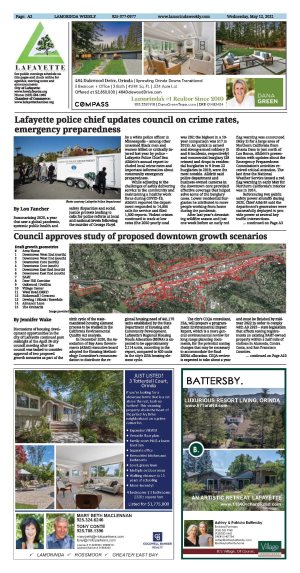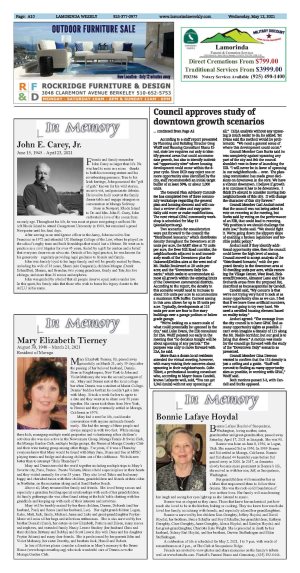| | Published May 12th 2021
| Council approves study of proposed downtown growth scenarios
| | | By Jennifer Wake |  | | Draft growth geometrics # Area Name 1 Downtown West End (north) 2 Downtown West End (south) 3 Downtown Core (north) 4 Downtown Core (south) 5 Downtown East End (north) 6 Downtown East End (south) 7 BART 8 Deer Hill Corridor 9 Oakwood / DeSilva 10 Village Center 11 West Road (MRT) 12 Bickerstaff / Crescent 13 Dewing / BRook / Rosedale 14 Almanor Lane 15 The Orchards |
Discussions of housing development opportunities in the city of Lafayette continued past midnight at the April 26 city council meeting after the council was tasked to consider approval of two proposed growth scenarios as part of the sixth cycle of the state-mandated housing element process to be studied in the California Environmental Quality Act analysis.
 In December 2020, the Association of Bay Area Governments (ABAG) executive board adopted the Housing Methodology Committee's recommendation to distribute the regional housing need of 441,176 units established by the State Department of Housing and Community Development. Lafayette's Regional Housing Needs Allocation (RHNA) is expected to be approximately 2,114 units, according to the report, compared to 400 units in the city's fifth housing element cycle.
In December 2020, the Association of Bay Area Governments (ABAG) executive board adopted the Housing Methodology Committee's recommendation to distribute the regional housing need of 441,176 units established by the State Department of Housing and Community Development. Lafayette's Regional Housing Needs Allocation (RHNA) is expected to be approximately 2,114 units, according to the report, compared to 400 units in the city's fifth housing element cycle.
 The city's CEQA consultant, ESA, will prepare a programmatic Environmental Impact Report, which is a more general environmental review for long range planning documents, for the potential zoning changes that may be necessary to accommodate the final RHNA allocation. CEQA review is expected to take about a year and must be finished by mid-year 2022 in order to comply with AB 2923 - state legislation that affects zoning requirements on existing BART-owned property within a half mile of stations in Alameda, Contra Costa, and San Francisco Counties.
The city's CEQA consultant, ESA, will prepare a programmatic Environmental Impact Report, which is a more general environmental review for long range planning documents, for the potential zoning changes that may be necessary to accommodate the final RHNA allocation. CEQA review is expected to take about a year and must be finished by mid-year 2022 in order to comply with AB 2923 - state legislation that affects zoning requirements on existing BART-owned property within a half mile of stations in Alameda, Contra Costa, and San Francisco Counties.
 According to a staff report presented by Planning and Building Director Greg Wolff and Housing Consultant Diana Elrod, state law requires not only to identify general areas that could accommodate growth, but also to identify individual "opportunity sites" where housing development could occur within the 8-year cycle. Since HCD may reject one or more opportunity sites identified by the city, staff recommended an initial target buffer of at least 50%, or about 1,000 units.
According to a staff report presented by Planning and Building Director Greg Wolff and Housing Consultant Diana Elrod, state law requires not only to identify general areas that could accommodate growth, but also to identify individual "opportunity sites" where housing development could occur within the 8-year cycle. Since HCD may reject one or more opportunity sites identified by the city, staff recommended an initial target buffer of at least 50%, or about 1,000 units.
 The General Plan Advisory Committee has completed two of three community workshops regarding the general plan and housing element and will conduct a review of sites and may potentially add more or make modifications. The next virtual GPAC community workshop is scheduled for May 13 (planlafayette.org).
The General Plan Advisory Committee has completed two of three community workshops regarding the general plan and housing element and will conduct a review of sites and may potentially add more or make modifications. The next virtual GPAC community workshop is scheduled for May 13 (planlafayette.org).
 Two scenarios for consideration were put forward to the council: the "Distributed Scenario," which distributes density throughout the Downtown at 50 units per acre, the BART sites at 75 units per acre, the Deer Hill Road corridor, the neighborhoods adjacent to and immediately south of the Downtown plus the Oakwood/DeSilva sites at the west end of Mt. Diablo Boulevard at 20 units per acre; and the "Downtown Only Scenario," which seeks to accommodate almost all growth within the existing limits of the Downtown commercial districts. According to the report, the density in this scenario would need to increase to about 115 units per acre to accommodate a maximum 62% buffer. Current zoning in this area allows for up to 35 units per acre. Typically, developments at 115 units per acre are four to five story buildings over a garage podium or below grade garage.
Two scenarios for consideration were put forward to the council: the "Distributed Scenario," which distributes density throughout the Downtown at 50 units per acre, the BART sites at 75 units per acre, the Deer Hill Road corridor, the neighborhoods adjacent to and immediately south of the Downtown plus the Oakwood/DeSilva sites at the west end of Mt. Diablo Boulevard at 20 units per acre; and the "Downtown Only Scenario," which seeks to accommodate almost all growth within the existing limits of the Downtown commercial districts. According to the report, the density in this scenario would need to increase to about 115 units per acre to accommodate a maximum 62% buffer. Current zoning in this area allows for up to 35 units per acre. Typically, developments at 115 units per acre are four to five story buildings over a garage podium or below grade garage.
 "We're looking on a macro scale of what could potentially be upzoned in the city," said Luke Evans, the EIR consultant for ESA. Wolff pointed out early in the meeting that "no decision tonight will be about upzoning of any parcels." The purpose was only to move forward with ESA, he said.
"We're looking on a macro scale of what could potentially be upzoned in the city," said Luke Evans, the EIR consultant for ESA. Wolff pointed out early in the meeting that "no decision tonight will be about upzoning of any parcels." The purpose was only to move forward with ESA, he said.
 More than a dozen local residents attended the virtual meeting, however, with many voicing their concerns about upzoning in their neighborhoods. Colin Elliott, a professional housing consultant who, according to Mayor Susan Candell, knows Lafayette well, said, "You can get 2,345 (units) without any upzoning at all." CEQA analysis without any upzoning is much easier to do, he added. Yet Evans said the method would be problematic: "We need a general sense of where this development could occur."
More than a dozen local residents attended the virtual meeting, however, with many voicing their concerns about upzoning in their neighborhoods. Colin Elliott, a professional housing consultant who, according to Mayor Susan Candell, knows Lafayette well, said, "You can get 2,345 (units) without any upzoning at all." CEQA analysis without any upzoning is much easier to do, he added. Yet Evans said the method would be problematic: "We need a general sense of where this development could occur."
 Council Member Cam Burks said he was completely against upzoning any part of the city and felt the council shouldn't vote in favor of launching the EIR. "I will never be in favor of upzoning in our neighborhoods . ever. The planning commission has made great decisions on downtown in the core. We have a vibrant downtown. I believe if growth is to continue it has to be downtown. I think it's absurd to consider moving into neighborhoods of this city. It will change the character of this city forever."
Council Member Cam Burks said he was completely against upzoning any part of the city and felt the council shouldn't vote in favor of launching the EIR. "I will never be in favor of upzoning in our neighborhoods . ever. The planning commission has made great decisions on downtown in the core. We have a vibrant downtown. I believe if growth is to continue it has to be downtown. I think it's absurd to consider moving into neighborhoods of this city. It will change the character of this city forever."
 Council Member Carl Anduri noted that the council was not being asked to vote on rezoning at the meeting, but Burks said by voting on the performance of an EIR, that could lead to rezoning. "My position is we should challenge the state law," Burks said. "We should fight it. We're going down the slippery slope of enabling a broken legislature and terrible public policy."
Council Member Carl Anduri noted that the council was not being asked to vote on rezoning at the meeting, but Burks said by voting on the performance of an EIR, that could lead to rezoning. "My position is we should challenge the state law," Burks said. "We should fight it. We're going down the slippery slope of enabling a broken legislature and terrible public policy."
 Anduri said if they identify additional opportunity sites, then the council could lower the high level of zoning. Council moved to accept analysis of the "Distributed Scenario," with the proposed density in the downtown area at 50 dwelling units per acre, while removing the Village Center, West Road, Bickerstaff/Crescent, Almanor Lane and The Orchards areas from the proposed list, described as inconsequential by Candell.
Anduri said if they identify additional opportunity sites, then the council could lower the high level of zoning. Council moved to accept analysis of the "Distributed Scenario," with the proposed density in the downtown area at 50 dwelling units per acre, while removing the Village Center, West Road, Bickerstaff/Crescent, Almanor Lane and The Orchards areas from the proposed list, described as inconsequential by Candell.
 Candell said, "My concern is that we're not trying very hard to look at as many opportunity sites as we can. I feel that if we leave these artificial numbers, we're not going to try very hard. We need a certified housing element based on reality today."
Candell said, "My concern is that we're not trying very hard to look at as many opportunity sites as we can. I feel that if we leave these artificial numbers, we're not going to try very hard. We need a certified housing element based on reality today."
 Anduri agreed: "The message from the city council is to have GPAC find as many opportunity sights as possible. I can't even imagine a density of 115 along the Mt. Diablo corridor, but our goal is to bring that down." A motion was made for the council go forward with the study of the "Downtown Only" scenario as presented.
Anduri agreed: "The message from the city council is to have GPAC find as many opportunity sights as possible. I can't even imagine a density of 115 along the Mt. Diablo corridor, but our goal is to bring that down." A motion was made for the council go forward with the study of the "Downtown Only" scenario as presented.
 Council Member Gina Dawson wanted to confirm that the 115 density is just a ceiling and a guide. "Staff will commit to finding as many opportunity sites as possible, in working with GPAC," Wolff said.
Council Member Gina Dawson wanted to confirm that the 115 density is just a ceiling and a guide. "Staff will commit to finding as many opportunity sites as possible, in working with GPAC," Wolff said.
 Both motions passed 3-2, with Candell and Burks opposed.
Both motions passed 3-2, with Candell and Burks opposed. |
| | | | | | | | | | | | |




